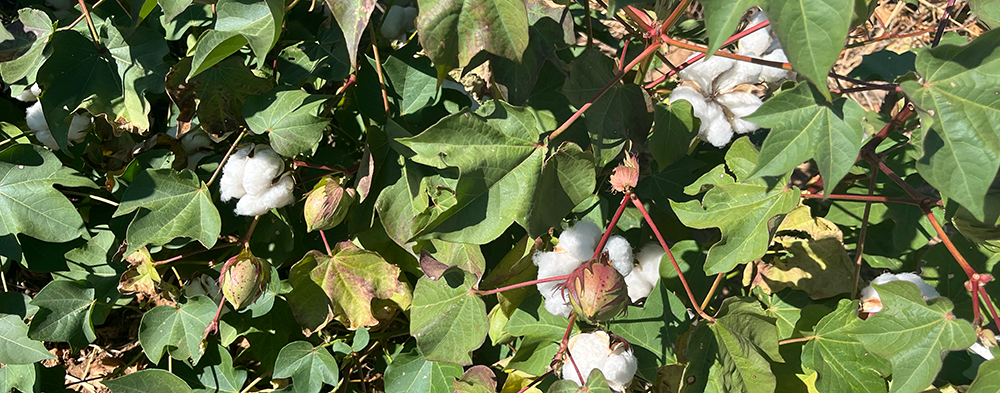Welcome to the September 8, 2023 issue of Cotton News, a service provided by Plains Cotton Growers Inc. for the cotton industry in the Texas High Plains and beyond.

Crop Outlook — IPM Edition
The Texas A&M University AgriLife Extension Service Entomology Department addresses water usage and pest conditions in their latest podcast. You can listen to it here: https://on.soundcloud.com/aoigD or read the breakdown by clicking on the tabs below.
Kerry Siders, IPM Agent for Cochran, Lamb and Hockley Counties
Kerry Siders, IPM Agent for Cochran, Lamb and Hockley Counties
It’s still hot and there are still a lot of questions about irrigation. I would encourage producers with a good crop to continue watering through this heat wave through Sunday. It looks like the National Weather Service is calling for a little break in the temperatures and even a little chance of rain for a good part of the High Plains next week, so I’d say that watering would be almost a must to get through this weekend.
The No. 1 thing is making certain that your crop can tolerate a certain amount of stress. If you have a late crop and those last bolls that you’re really counting on contributing to yield are not over 20 days old (set around August 15 through 20) then they should be able to take some moderate stress by this weekend. Again, if we see these temperatures go down to the lower 90s and into the high-80s to mid-80s, and man if we just get a little help, those crops should be in decent shape. However, we’ve got to be careful what we pray for. If we get a big deluge of rainfall my concern is we’ll see some regrowth occurring. That’s not going to help in any respect; in fact, it will make things more difficult when we get to harvest. I know we’ll always take a rain — we’ve all said this — and there’s not anything we can do about it. It’s just important to understand the consequences of a big rain from this point on.
Regarding insects, we have put most everything to bed. Still keep an eye out for cotton aphids and Lygus, but here in my territory, I have not been picking up on those insects. In fact, in terms of aphids the beneficials have pretty much cleaned them out, not just in cotton but also in some of our grain crops.
If we do get some rains next week and a lot of hard ground softens up, it would be a great time to get some nematode sampling done. I know a lot of y’all have questions about harvest aids — many of us will have that information coming soon about the timing and products. I hope to have some harvest aid demonstrations out soon that will provide you with some numbers.
John Thobe, IPM agent Bailey, Castro and Parmer Counties
John Thobe, IPM agent Bailey, Castro and Parmer Counties
Kerry said it best when he said we’re going to put some water to it and on it. I think a lot of my guys are speeding up pivots right now and trying to get that one last pass in — maybe finish the pass they’re on.
I’m not seeing anything out there entomologically right now save for some stink bugs and things like that that are starting to work their way into cotton and sorghum heads just here and there. It’s not a huge concern yet. And the boll worms have gone from essentially a little bit of a potential threat to almost nothing so far. Not to say they couldn’t be a potential threat here moving into the middle of September, but for right now we’re not seeing a whole lot of pressure there.
Keegan McCollum, IPM agent for Gaines County
Keegan McCollum, IPM agent for Gaines County
I want to echo what Kerry and John have both said about cotton with the potential rain coming next week. We really want to keep an eye on our watering. We don’t want it to get too growthy or late in the season, but most fields I don’t think are going to have a big issue as small as they are currently.
Blayne Reed, IPM agent for Hale and Swisher County
Blayne Reed, IPM agent for Hale and Swisher County
I still have a few fields of cotton that have a bit of lush to them and some bolls up top that have a decent chance of making. We’ve got a tremendous beneficial population taking care of any boll worm threat. We are still looking at some Lygus out there, and I’ve got a handful of fields with bolls up top that can make that are still at risk for those pests. We treated some fields late last week — I hope we don’t run into any this week. We do still need to be watching for aphids and the stink bugs.
Our late crops like 10% to 20% of our acres are still at peak water use – we’ve got time to make it, unless we get a September freeze, but we’re still running pretty high temperatures at night. This isn’t necessarily out of the ordinary. We’re still watching several fields with the most mature crops looking at irrigation management and being very careful about what drops we put where this time of year. Are we just boll filling or if we’re trying to water blooms that have no chance. Be careful this time of year and make sure your inputs will pay back.